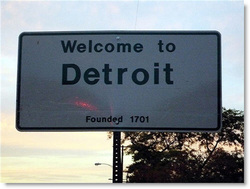
Detroit recently filed for bankruptcy protection. Individuals normally file chapter 7 or chapter 13 bankruptcies (and in few situations chapters 11 or 12). However, cities have their own bankruptcy chapter - a chapter 9.
A chapter 9 bankruptcy allows a city to seek protection from its creditors. For most cities (and Detroit particularly) payments owing to retired workers is a major source of funds owing. It is estimated that Detroit was spending close to 6 billion dollars a year on pension plans. Ouch. Another large source of creditors for cities are municipal bonds.
Cities file for bankruptcy to work out payments owing to its creditors. Like in other bankruptcy chapters, Detroit will enjoy the benefits of the automatic stay - meaning its creditors cannot undertake collection activities against Detroit. Collection activities is a broad term, but it definitely includes things like filing law suits, liens, and even phone calls trying to collect. Detroit will have to file a proposed plan that is agreeable to its creditors including its pensioners. This plan will include a significant reduction in payments owing to its retirees, but it will also likely include selling substantial assets held by Detroit like its airport and city parks. These funds are used to pay down debts.
So how does a city file for bankruptcy? In much the same way an individual would. Assets of the city are used to pay down debt that is eventually wiped clean. Realistically, bankruptcy hurts cities short term, but they may be a very effective long-term solution to rising debts and lower revenue.
A chapter 9 bankruptcy allows a city to seek protection from its creditors. For most cities (and Detroit particularly) payments owing to retired workers is a major source of funds owing. It is estimated that Detroit was spending close to 6 billion dollars a year on pension plans. Ouch. Another large source of creditors for cities are municipal bonds.
Cities file for bankruptcy to work out payments owing to its creditors. Like in other bankruptcy chapters, Detroit will enjoy the benefits of the automatic stay - meaning its creditors cannot undertake collection activities against Detroit. Collection activities is a broad term, but it definitely includes things like filing law suits, liens, and even phone calls trying to collect. Detroit will have to file a proposed plan that is agreeable to its creditors including its pensioners. This plan will include a significant reduction in payments owing to its retirees, but it will also likely include selling substantial assets held by Detroit like its airport and city parks. These funds are used to pay down debts.
So how does a city file for bankruptcy? In much the same way an individual would. Assets of the city are used to pay down debt that is eventually wiped clean. Realistically, bankruptcy hurts cities short term, but they may be a very effective long-term solution to rising debts and lower revenue.

 RSS Feed
RSS Feed